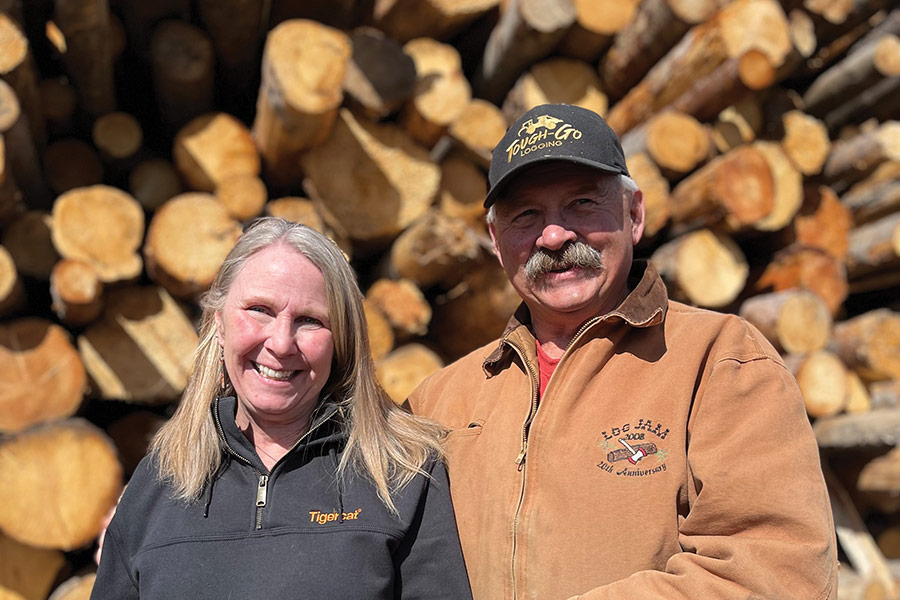It’s ‘a God Thing’
By Bob Johnson
Veteran logger James Stupack has refused to allow personal setbacks prevent him from doing good deeds for his employees and the Kalispell community.
What many call divine intervention—a miracle-like occurrence for which there is no logical explanation—James Stupack describes simply as “a God thing.”
The 70-year-old owner of Wild Montana Wood and Tough Go Logging in Kalispell says he has experienced two “God things” since 1994. That year, in August, he met his future wife, Jennie, while attending a rodeo at the local fairgrounds. Six years later, the second “God thing” occurred when he was able to purchase a 24-acre parcel that was part of an old ranch—a ranch on which he had cowboyed as a young man—from the county for 70 percent of its appraised value.
While there certainly had been a life well lived prior to those mileposts—how could there not have been for a man who had been nicknamed “Hippie Jim”? It has been life’s second half that has seen him shine as a beacon of perseverance. Following an accident that would have broken many, Stupack has found ways to keep his “guys” employed, help those in need in the logging and local communities, and benefit other small businesses in and around Kalispell.
The accident is what Stupack describes as “a bad wreck on a dozer. It busted my lower-left femur, broke my back and I lost my lower-right leg. Basically, they told me I was going to be a shoe salesman or something.”
It was a dark time. Stupack was down, but thanks to Jennie, not out.
“I had six kids to raise. Jennie told me, ‘You can get through this. We’ll keep you going.’ She was a champion at pushing me. My 14-year-old son would drive me to the jobs.”
Stupack and Jennie had started dating only months prior to the accident, yet she stayed by his side the entire month-and-a-half he convalesced in the hospital.
Stupack was 40, in the prime of his working life, and in a split second, everything changed. Nothing would ever be the same, but thanks to Jennie, he says, it would be okay—even better.
To watch Stupack walk, one would never suspect he has a prosthetic leg. There is no trace of a limp. If anything, he exhibits exceptional posture for a man with seven decades, most of that time in the logging industry, under his belt.
“I’m some kind of freak,” he says with a smile. “My body took to this fake leg really good. I’ve actually killed more elk since I lost the leg.”
Russ Miller, who oversees Wild Montana Wood‘s specialty log business with the unofficial title of Stupack’s “right-hand man,” says the improvement in elk hunting is easily explained: “He learned this thing called patience.”
He also learned to embrace the wintertime.
“The climate up here is kind of more conducive to wearing a prosthetic leg,” he says. “A hot summer can be rough because you sweat and can’t keep it on.”
Buoyed by the support of his wife, Stupack took the necessary time to heal following the accident, which also gave him time to think.
“We were still chain sawing,” he recalls. “I was thinking, ‘How can we keep this thing going?’”
In trying to figure out his next move, Stupack drew from his extensive experience in the logging industry. He had already survived a “must-change” era early in his career when the widespread clear cuts of the 1970s drew the attention and ire of environmentalists. An early niche involved streamside management.
“At the time, all the trees along these creeks were just being taken out,” Stupack recalls. “But the trees had a purpose—to shade the area and keep it cooler. The idea was that they didn’t all have to be cut down. The streamside management projects took a lot more work, but they made a difference.”
They also demonstrated that environmentalists and loggers didn’t always have to be, for lack of a better term, at loggerheads.
In 2004, the United States Forest Service began issuing stewardship contracts, wherein independent loggers like Stupack could compete with the giant logging companies because the contracts “weren’t based on best prices, but instead on the best ideas and best practices.”
Stupack was interested, and his foreman at the time explained what was needed to put forth an application: a masticator.
“He showed me one, and I was impressed,” Stupack recalls. “It had a drum roller mounted on the boom of an excavator with 24 teeth just gnawing stuff up. We went out and watched it work on a logging job on the Palouse. We thought we could go through the forest with all these stands of little trees and just grind them up.”
The fires that burned through Montana in 2000, scorching nearly 600,000 acres, had prompted everyone—the Forest Service, environmentalists and loggers—to focus on forest management as a means of fire prevention.
Stupack liked what he had seen and was ready to make a proposal. He even knew what he was going to tell the Forest Service: “We’re going to thin your forest. We’re going to make it look real pretty, and it’s going to just throw little chips all over the place.”
Stupack had followed his foreman’s advice: “Just B.S. You know how to B.S.”
Apparently so, because the Forest Service awarded Stupack a contract on a 300-acre project.
Great! And uh-oh.
“Now they wanted to see this thing work,” Stupack chuckles. “But we didn’t have a machine yet. Now what?”
Fortunately, Stupack had a good working relationship with John King at Three Rivers Bank.
“They’ve just always listened to our ideas and stood behind us,” Stupack says. “I think we refinanced our whole operation seven times in 12 years with them. They know the business and said, ‘Yeah, let’s do it.’”
Also needed for the project was an excavator, another expensive piece of machinery that Stupack couldn’t afford. But an auction was coming up in Gillette Wyoming, and Stupack and Jennie decided to go. There, Jennie spotted a 1996 Hitachi EX200 with a sign reading “Excellent Excavator” taped to it.
“We bought it for $36,000,” Stupack says.
After figuring out how to put the masticator and excavator together and make the contraption work, Stupack was now in the forest stewardship business.
Things were going well. Then came 2008. The economy tanked. Contracts dried up. Mills stopped paying reasonable prices for product.
“We logged only three months that year,” Stupack laments. “But the wood industry goes up and goes down. The economy would get better. We just had to find a way to ride it out.
“I had to think again.”
Fortunately, Stupack was able to work out a deal with Caterpillar to park a specialized machine and make just interest payments until things turned around. But he still had a crew that depended on him for their livelihoods.
That’s when the 24-acre piece of land he’d bought from the county came into play. He would refinance yet again and build a yard for cutting and selling firewood—and not by the bundle, but at a more consumer-friendly per-pound rate.
A used set of truck scales was installed, a firewood processor was purchased and then Russ Miller, who had been working at the Plum Creek Mill, stopped by to see the operation and offer help. He suggested that Stupack also sell some other types of logs to diversify.
As it turned out, Miller was ready to move on from Plum Creek.
“We worked a deal where he’d work here and sell (specialty) logs from here,” Stupack says. “I couldn’t pay him what (Plum Creek) paid, but he found a way to make it work. He starts talking to customers about the logs and they fall in love with them.”
Miller’s willingness to help, even before forging an official relationship with Wild Montana Wood, is an example of what Stupack says makes the logging industry in northwest Montana unique.
“These loggers up here—we’re competitors, but we also help each other out. These guys are phenomenal. All through the episode of losing my leg, these guys helped me out with ideas. When someone’s machine breaks down it’s ‘I have an extra one; here you go.’”
That mindset was formalized with the formation of the Montana Logging Association, which stages an annual fundraising event “Log Jam Inc.” the first Saturday in October to benefit families of Montana loggers, log truck drivers, chip truck drivers and mill workers injured or lost in work-related accidents. To date, more than $643,000 has been donated.
Stupack also participates in Hoo-Hoo of Northwest Montana, the fraternal order of the forest products industry founded in 1892, which has organized a Needy Children’s Fund for local families.
Even Wild Montana Wood’s firewood program contributes to the community in both direct and tangential ways.
“Sometimes people will drive in with a car, shivering, and we’ll just give them wood,” Miller says. “We may write it off to Hoo-Hoo or we may not. The community relies on this place.”
Customers also have the option of dropping off a pickup or trailer, having the crew fill it with wood and picking it up later.
“A lot of people will bring a second car and then go into town to shop,” Stupack points out. “That helps out other small businesses.”
Wild Montana Wood also donates wood to various functions and fundraisers.
“People helped me when I needed it,” Stupack says, adding that their generosity informed his own view on philanthropy. “Now, we’re in a position to help. Why wouldn’t we?”
The good news for the greater Kalispell community is that Stupack has no plans to retire.
“I know wood,” he says. “That’s my thing. I like people. And I like doing this. So I’m going to keep doing this for a long time, the Good Lord willing.”
That would be another God thing. MSN









